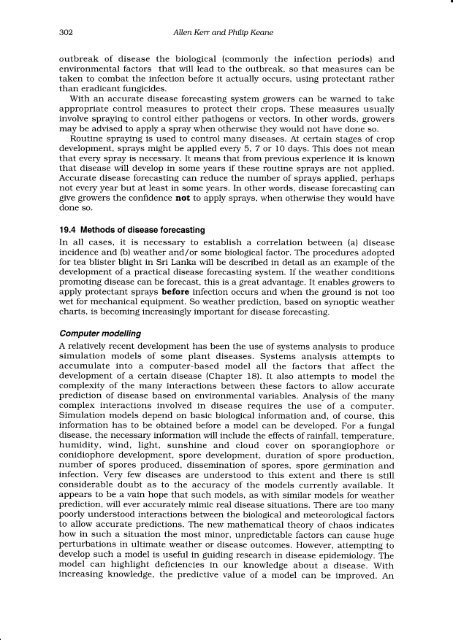PREDICTION OF DISEASE OUTBREAKS AIlen Kerr and Philip Keane
PREDICTION OF DISEASE OUTBREAKS AIlen Kerr and Philip Keane
PREDICTION OF DISEASE OUTBREAKS AIlen Kerr and Philip Keane
Create successful ePaper yourself
Turn your PDF publications into a flip-book with our unique Google optimized e-Paper software.
302 Allen <strong>Kerr</strong> <strong>and</strong> Philtp <strong>Keane</strong><br />
outbreak of disease the biological (commonly the infection periods) <strong>and</strong><br />
environmental factors that will lead to the outbreak, so that measures can be<br />
taken to combat the infection before it actually occurs, using protectant rather<br />
than eradicant fungicides.<br />
With an accurate disease forecasting system growers can be warned to take<br />
appropriate control measures to protect their crops. These measures usually<br />
involve spraying to control either pathogens or vectors. In other words, growers<br />
may be advised to apply a spray when otherwise they would not have done so.<br />
Routine spraying is used to control many diseases. At certain stages of crop<br />
development, sprays might be applied every 5,7 or l0 days. This does not mean<br />
that every spray is necessary. It means that from previous experience it is known<br />
that disease will develop in some years if these routine sprays are not applied.<br />
Accurate disease forecasting can reduce the number of sprays applied, perhaps<br />
not every year but at least in some years. In other words, disease forecasting can<br />
give growers the confidence not to apply sprays, when otherwise they would have<br />
done so.<br />
19.4 Methods of disease forecasting<br />
In all cases, it is necessary to establish a correlation between (a) disease<br />
incidence <strong>and</strong> (b) weather <strong>and</strong>/or some biological factor. The procedures adopted<br />
for tea blister blight in Sri Lanka will be described in detail as an example of the<br />
development of a practical disease forecasting system. If the weather conditions<br />
promoting disease can be forecast, this is a great advantage. It enables growers to<br />
apply protectant sprays before infection occurs <strong>and</strong> when the ground is not too<br />
wet for mechanical equipment. So weather prediction, based on slmoptic weather<br />
charts, is becoming increasingly important for disease forecasting.<br />
Computer modelling<br />
A relatively recent development has been the use of systems analysis to produce<br />
simulation models of some plant diseases. Systems analysis attempts to<br />
accumulate into a computer-based model all the factors that affect the<br />
development of a certain disease (Chapter 18). It also attempts to model the<br />
complexity of the many interactions between these factors to allow accurate<br />
prediction of disease based on environmental variables. Analysis of the many<br />
complex interactions involved in disease requires the use of a computer.<br />
Simulation models depend on basic biological information <strong>and</strong>, of course, this<br />
information has to be obtained before a model can be developed. For a fungal<br />
disease, the necessary information will include the effects of rainfall, temperature,<br />
humidity, wind, light, sunshine <strong>and</strong> cloud cover on sporangiophore or<br />
conidiophore development, spore development, duration of spore production,<br />
number of spores produced, dissemination of spores, spore germination <strong>and</strong><br />
infection. Very few diseases are understood to this extent <strong>and</strong> there is still<br />
considerable doubt as to the accuracy of the models currently available. It<br />
appears to be a vain hope that such models, as with similar models for weather<br />
prediction, will ever accurately mimic real disease situations. There are too many<br />
poorly understood interactions between the biological <strong>and</strong> meteorological factors<br />
to allow accurate predictions. The new mathematical theory of chaos indicates<br />
how in such a situation the most minor, unpredictable factors can cause huge<br />
perturbations in ultimate weather or disease outcomes. However, attempting to<br />
develop such a model is useful in guiding research in disease epidemiologr. The<br />
model can highlight deficiencies in our knowledge about a disease. With<br />
increasing knowledge, the predictive value of a model can be improved. An







![[Compatibility Mode].pdf](https://img.yumpu.com/27318716/1/190x135/compatibility-modepdf.jpg?quality=85)









